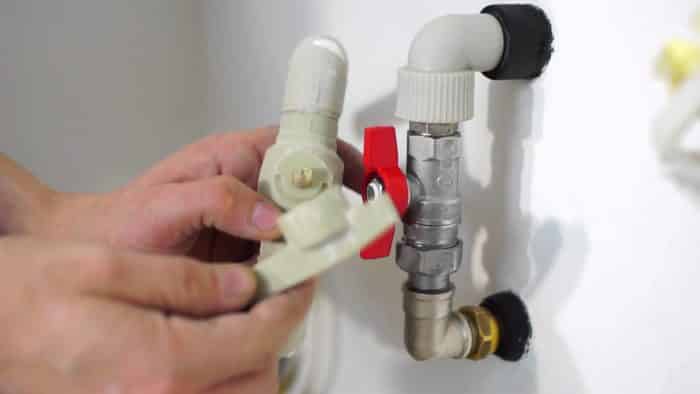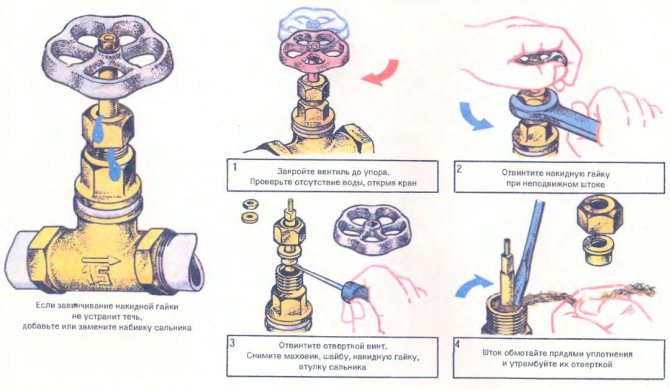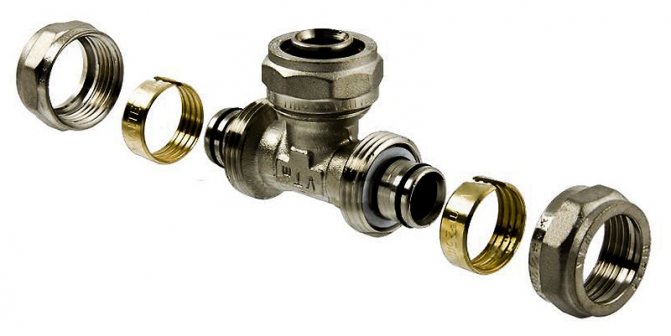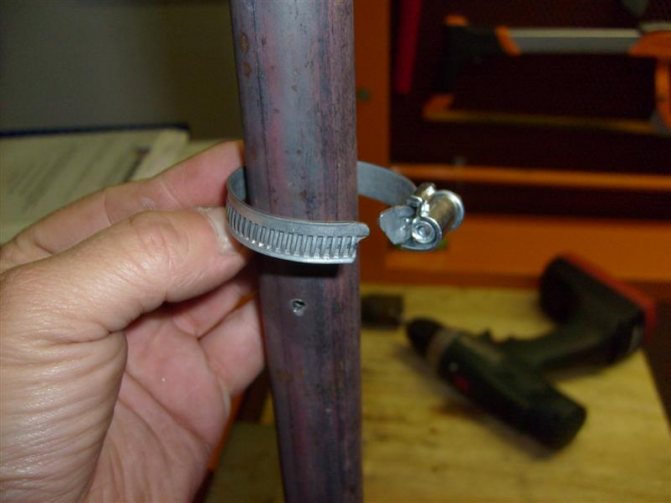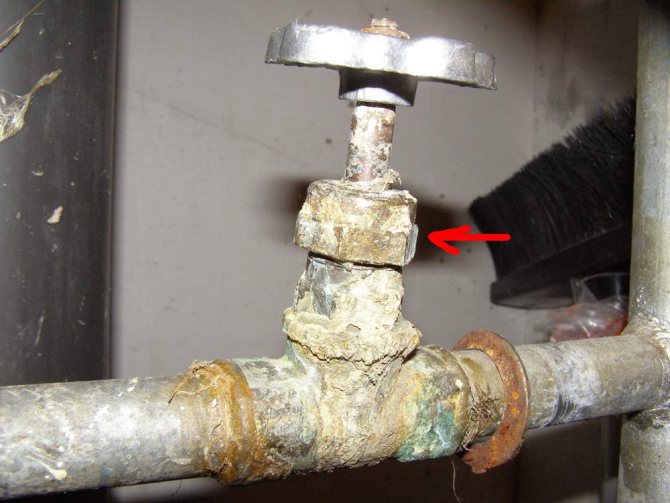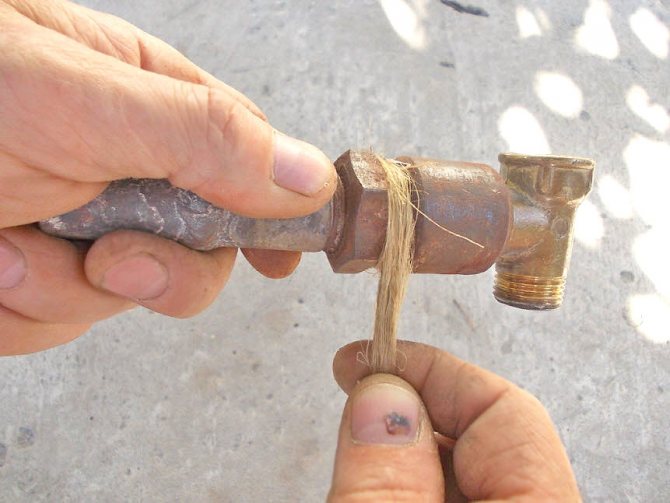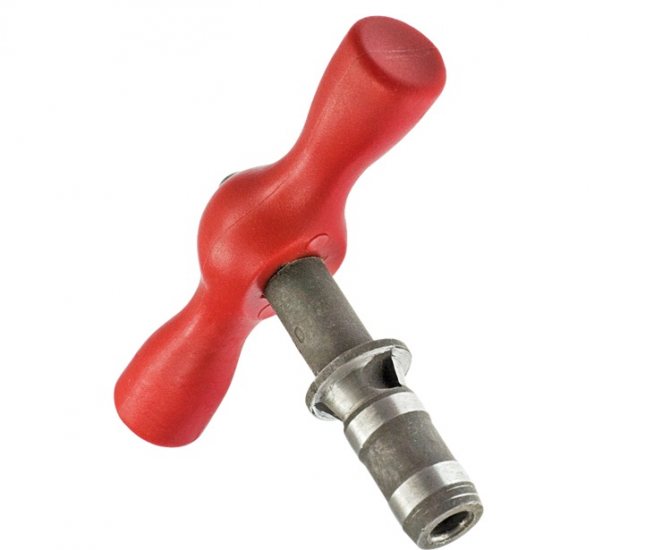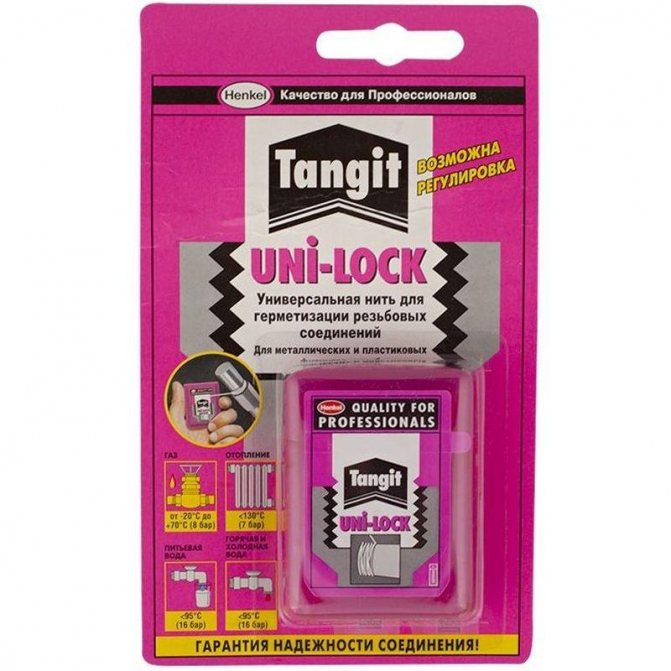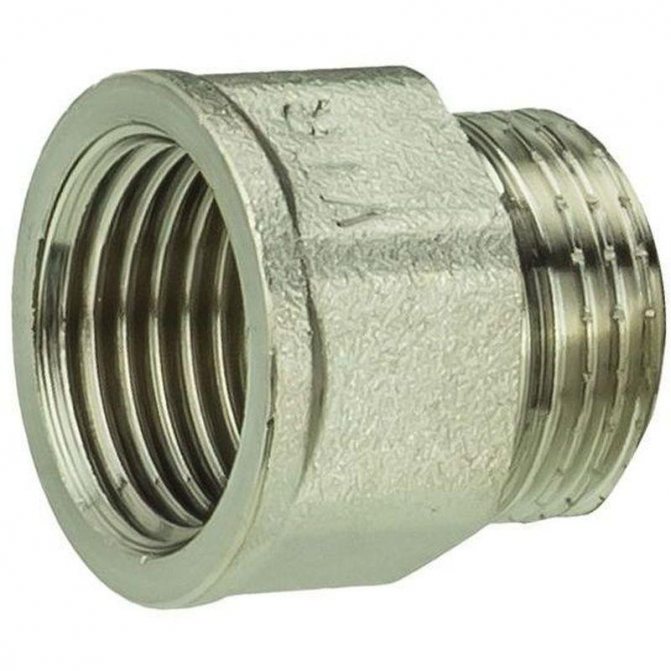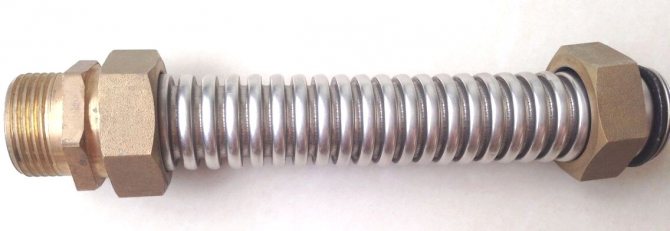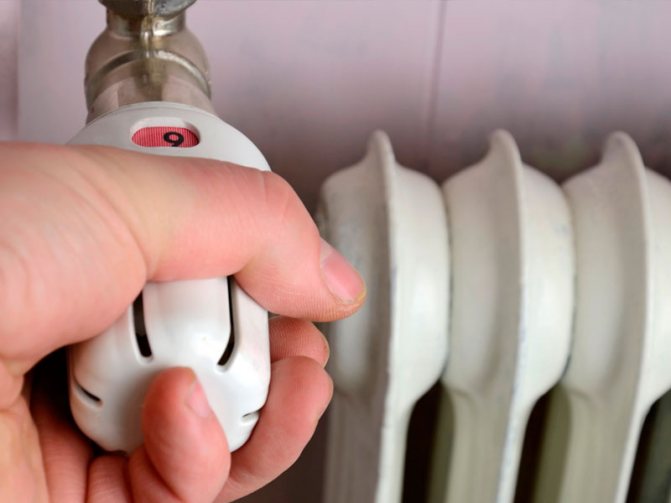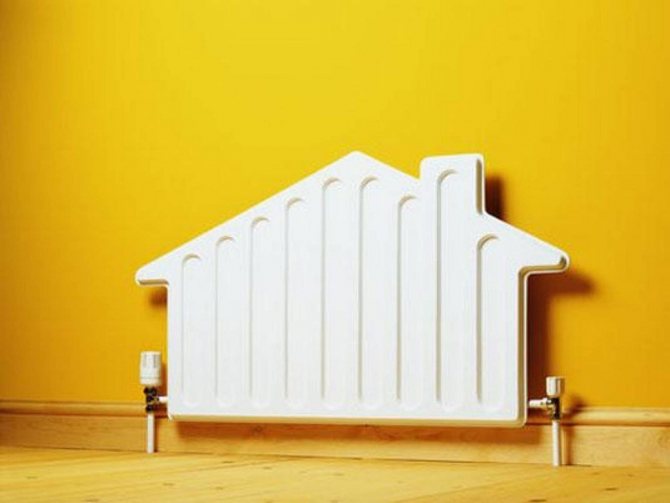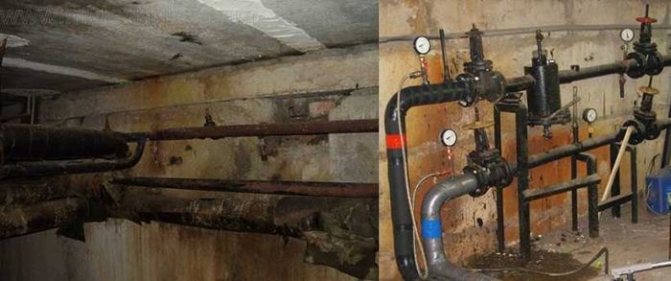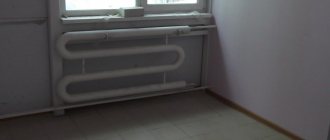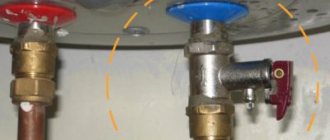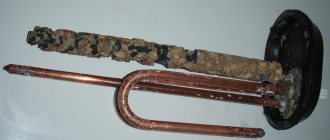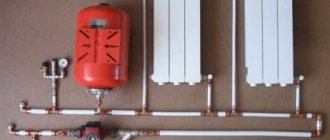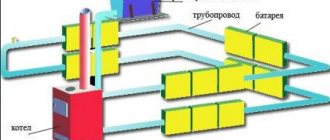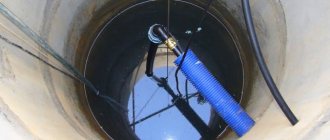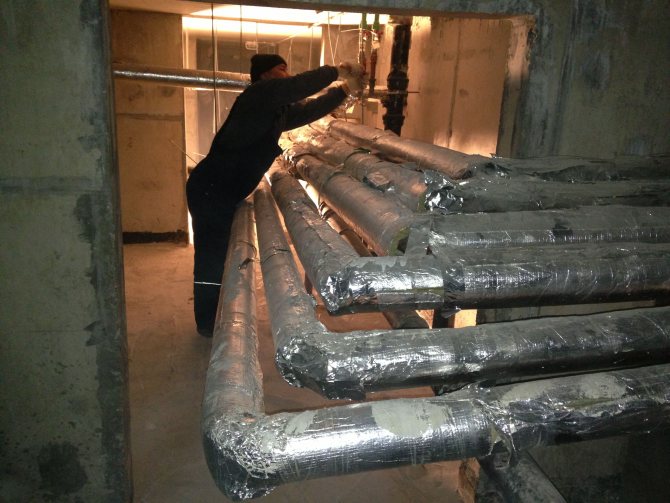
Technical basement in an apartment building
Nobody is immune from communal problems. In the event of an accident and flooding of the apartment, the first thing to do is call the emergency service, working around the clock. However, the emergency gang's capabilities are limited: it processes requests in the order they are received.
Today we have to learn how to independently block the risers in the basement in case of an accident or for repair work in an apartment.
HVS
If an accident occurs in your apartment, the source of the leak is usually not in doubt. With flooding along the riser, it is a little more difficult: in this case, you need to localize the problem (see Leaks in the basement: causes, symptoms, elimination).
Signs
- The leak started in the bathroom, in the kitchen, in the closet or in the hallway next to them;
Hint: with high-quality waterproofing of the floor in the corresponding rooms, water begins to flow to the neighbors from below only after the floor has been flooded to the threshold. In the corridors and hallways, there are no sanitary cabins that protect against leaks and any effective waterproofing.
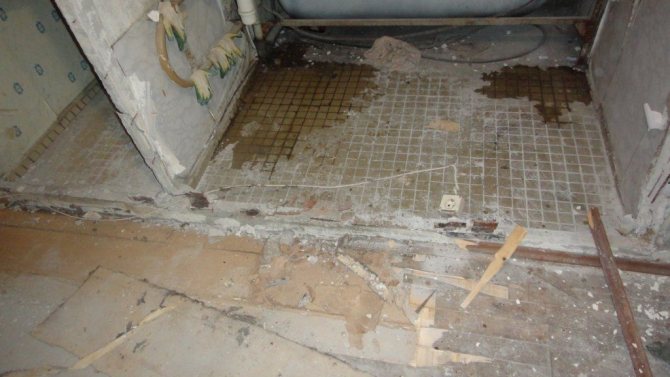

Bathroom floor often keeps water from leaking
- The incoming water is at a low temperature;
- She comes in continuously... With a cyclical occurrence of a leak, you can suspect a sewer blockage in the upper apartment. In the latter case, water flows to the floor only when it is drained through the taps.
Captain The obvious suggests: before taking any action, visit the neighbors upstairs. Many problems can be fixed without turning off the water. For example, a fistula on a liner or a riser is bandaged using an aluminum clamp or knitting wire, pliers and a gasket for a crane box.
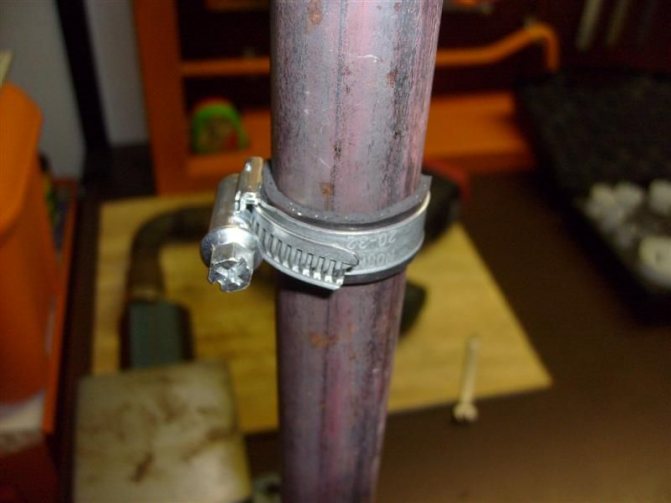

Riser fistula bandage
Finding and disconnecting a riser
The HVS riser related to your apartment is easiest to find in the basement by its location relative to the flight of stairs. The valve is usually located at the outlet of the riser from the filling. A tee with a plug or (less often) a vent is mounted next to it.
The sequence of actions is pretty obvious:
- We close the valve on the riser. The screw valve is twisted up to the stop, the ball or plug valve is rotated 90 degrees;
A nuance: many cork valves are supplied and installed without handles. To turn off such a faucet, you will need a pipe or adjustable wrench.
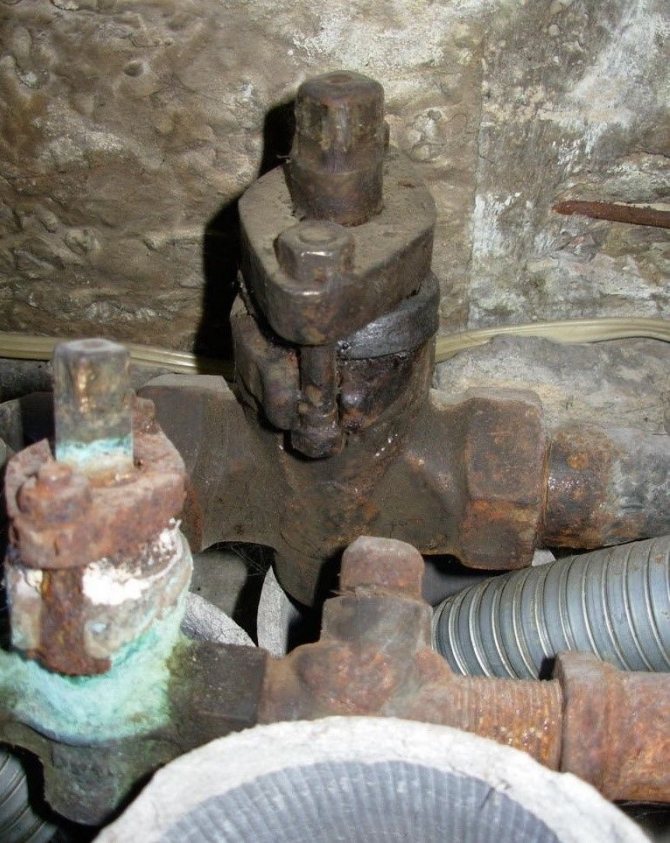

The plug valve is closed with a key
- Partially (we emphasize - partially, until the moment when water flows along the thread), unscrew the plug and wait for the drop in the pressure of the flowing water;
- If the pressure is safely asleep, you can go up to the apartment and wait for the emergency service you called. If this does not happen, the valve on the riser is faulty (the gasket is destroyed, the valve is torn off, the seat in the body is broken, etc.). In this case, we need to go in search of a water metering unit.
Disconnecting the water meter
Turning off the water in the water meter will leave the whole house without it. The good news is that the stop valves in the water meter are almost always in good working order, since they are checked annually by representatives of the water supplying organization.
The water meter can be found:
- By the inscription "VU" on the wall of the house at the entrance to the basement;
- By the location of the cold water supply or the well of the Water System;
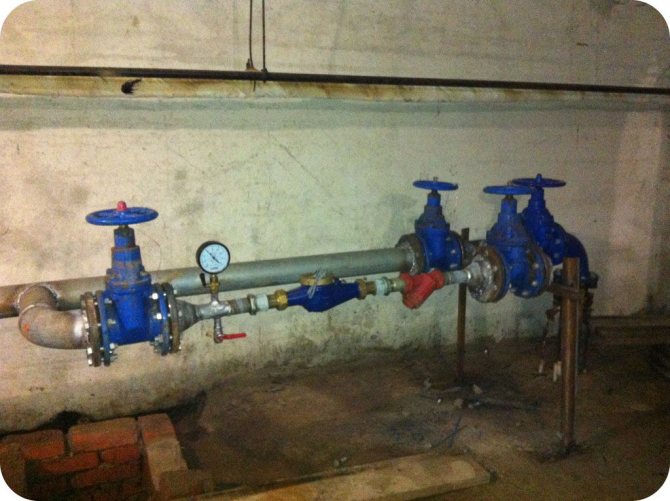

The water meter is installed at the cold water inlet to the building
However: the well of the Vodoseti is easy to confuse with the wells of the yard sewage located along the house.
- Finally, the water meter can be found by walking along the cold water filling and finding a bend or outlet of the same diameter as the filling itself.
In the water metering unit, any valve located next to the water meter is closed. If there is a bypass valve in the water meter, when the water meter is installed, the valve on it is closed and sealed.
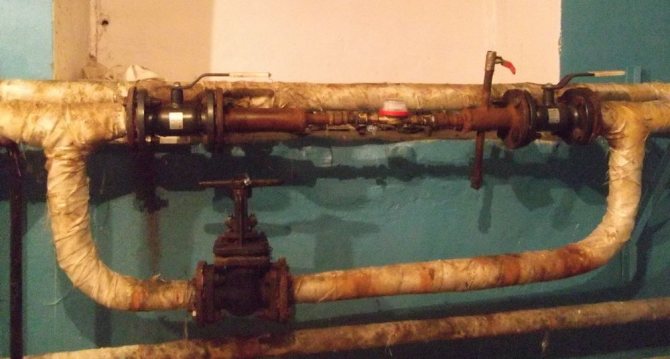

Water meter with a sealed bypass
At the time of checking the meter, water is supplied through the bypass after removing the seal from the valve or valve; if this is your case, block the bypass line.
Attention: do not forget to fully open the valve on the riser after turning off the water meter, otherwise you have every chance of getting a significant drop in the water pressure in the peaks of its analysis (in case the valve partially blocked the water). Do not be lazy to submit an application to the managing organization for the repair of fittings on the riser.
Autonomous water supply
Now let's take a look at autonomous cold water supply in homes: repair and adjustment are required for these systems as well.
First, a few words about how the water supply from a well or well works:
- The pump raises the water and creates excess pressure in the water supply system;
- The hydraulic accumulator smooths out pressure surges when the pump is turned on and stores water, allowing the pump to be idle for a significant part of the time;
- The pressure sensor monitors the number of atmospheres in the water supply system and, when the pressure drops to a critical level, turns on the pump, and when it rises to the set value, turns it off.
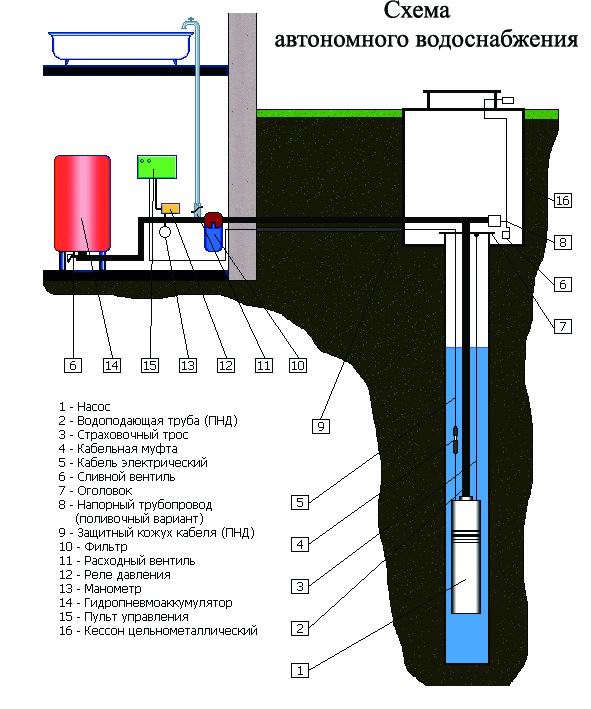

The device of the autonomous water supply system
Understanding the principle of operation of an autonomous water supply system, it is not difficult to diagnose problems in it.
If the pump turns on frequently, this may indicate:
- Excessively small volume of the accumulator;
- Understated pressure for switching on the pump.
Captain Evidence suggests: in the first case, it is required to install a more capacious accumulator, in the second - to adjust the pump automation.


Do not forget that the effective volume of the accumulator is less than its total volume and depends on the pumping pressure, pump on and off pressures
If the pump does not turn off, the obvious reason is the overpressure of its shutdown, which exceeds the head created by the impeller. The solution to the problem in this case also comes down to adjusting the automation.
DHW
In case of any leaks of hot water supply in your apartment, the first thing you do is close the valve or ball valve on the liner.
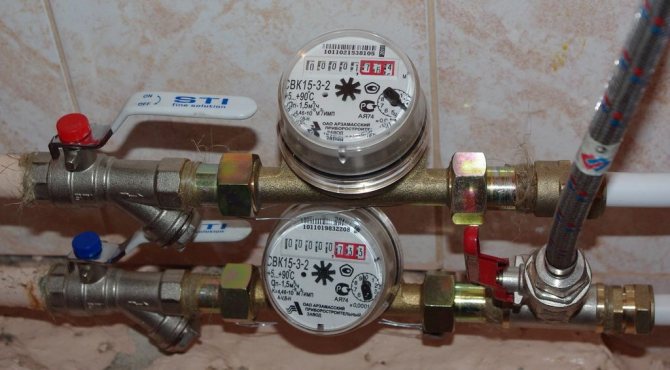

Taps on cold water supply and hot water supply
If a leak occurred before the valve (on a heated towel rail, a riser, or at the seam between the riser and the liner), or if you are drowned from above, your path lies in darkness and dampness. To the basement.
Signs of a DHW leak
- The apartment is heated in rooms in which hot water is supplied, or in those adjacent to them;
- You are flooded with warm water from above;
Let's clarify: in the kitchen, it is sometimes possible to localize the cause of the leak only by the location of the leak on the ceiling (closer to the sink or to the heater).
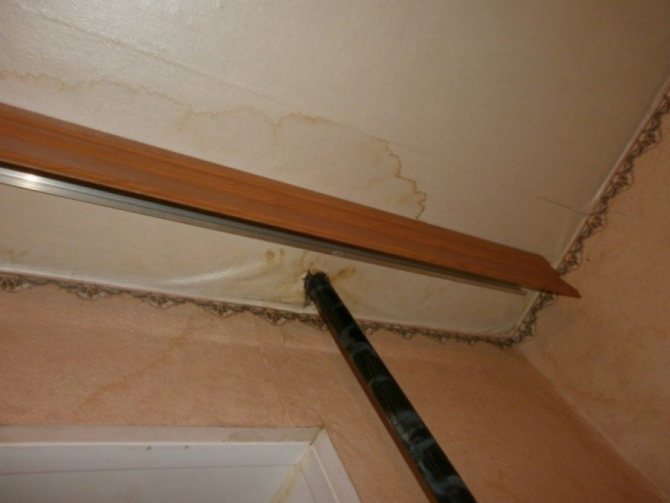

A leak near the kitchen heating pipe reveals the cause of the leak
- Water flows continuously.
Finding and disconnecting a riser
In houses built before the early 80s, turning off the hot water supply is completely identical to turning off the cold water riser. The hot water supply system in these buildings is dead-end, and each riser is connected only to the filling and to the connections in the apartments.
In most newer apartment buildings, DHW is circulating. For us, this means that each riser is connected by a lintel on the upper floor with other risers (there can be from one to six).
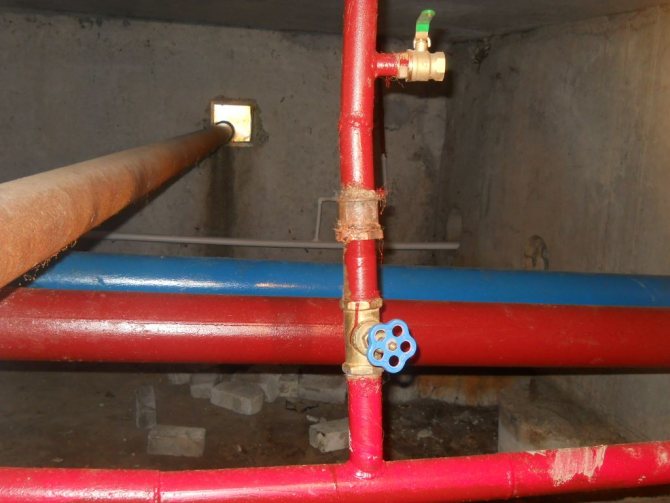

Hot water circulation sign - two hot water dispenses
Hint: most often, DHW is ringed on the apartment (if there are at least two DHW risers in it - in the kitchen and in the bathroom / toilet) and to the entrance.
The sequence of actions when disconnecting DHW with circulation is as follows:
- Close your riser and partially (we emphasize again: partially!) Unscrew the cap;
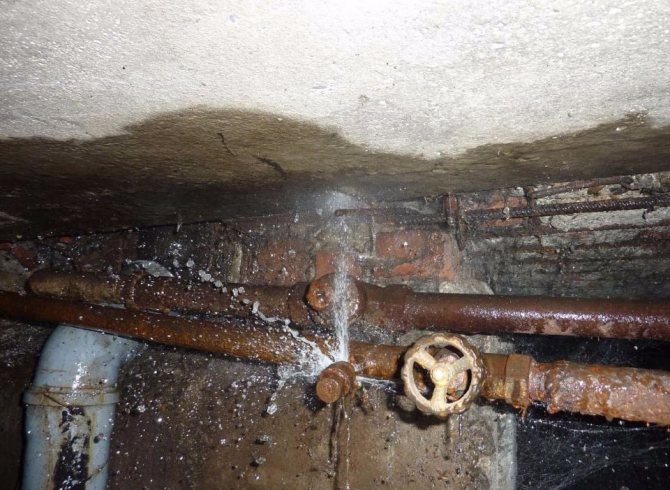

Partially unscrewed plug allows you to control the pressure in the riser
- Block off adjacent risers one at a time without touching the plugs on them. You need to wait for the moment when the pressure of the water coming from under the plug on your riser drops;
- Then open the taps one at a time.If the pressure does not increase at the same time, the riser is not connected with yours, and it must be completely opened;
- Having found all the risers combined into a group, unscrew the plug on yours.
If at least one unit of fittings is faulty, you will have to turn off the hot water supply for the whole house. In the most common houses in the post-Soviet space with an open heat supply circuit (read - with the supply of hot water from the heating network), this is done in the elevator unit.
Disconnection of DHW in the elevator
First, a little theory.
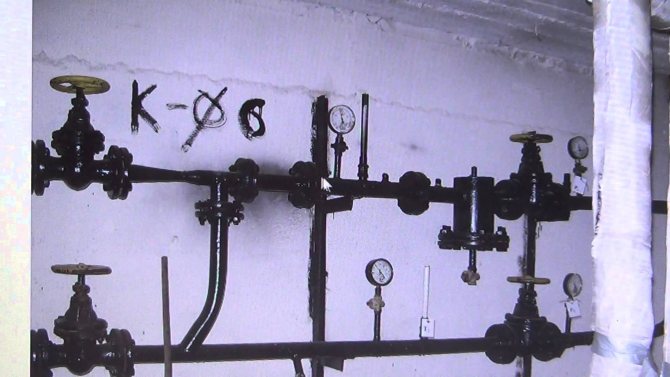

Heating elevator unit
The heating elevator unit includes:
- Inlet shut-off valves (gate valves, ball valves or valves), cutting it off from the heating main. The upper valve turns off the feed line, the lower one - the return;
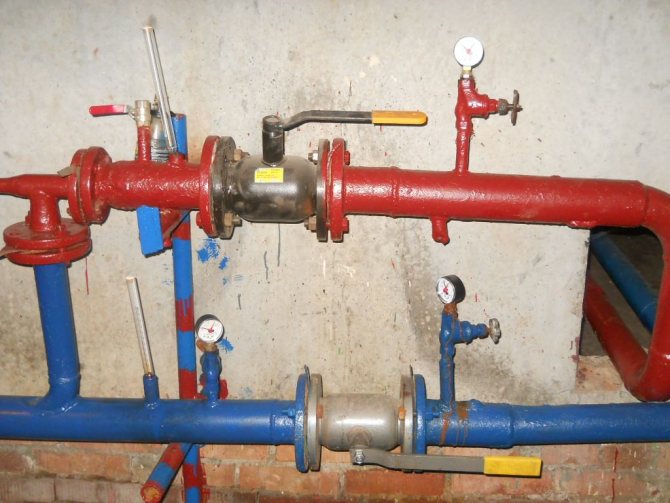

Inlet shut-off valves - ball valves
- House fittings that turn off the heating system of the house;
- Control valves and pockets for temperature measurement;
- Suction - a jumper connecting the supply with the return;
- The water jet elevator to which this jumper is connected. It is a tee with a socket on one of the branches, and a nozzle installed inside.
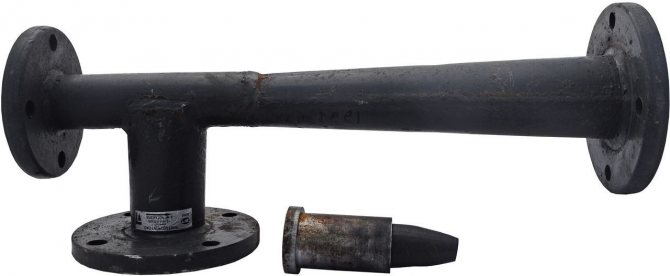

Elevator with nozzle
The nozzle is responsible for the metered supply of hot and high-pressure water from the supply to the mixing chamber, where it is mixed with the return water cooled in the heating circuit. Thus, part of the return coolant is involved in recirculation; so the elevator provides a large volume of circulating fluid at its minimum flow rate on the supply pipe of the heating main.
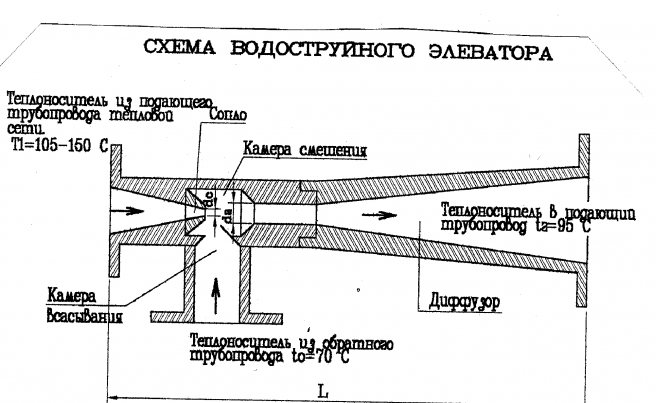

The principle of operation of the mixing chamber
Please note: the water jet elevator always faces the heating system and house valves.
DHW connections are located between the inlet valves and the elevator. Usually there are 2 of them (in a dead-end DHW system) or 4 (in a circulation system). To turn off hot water for the whole house, all tie-ins must be blocked.
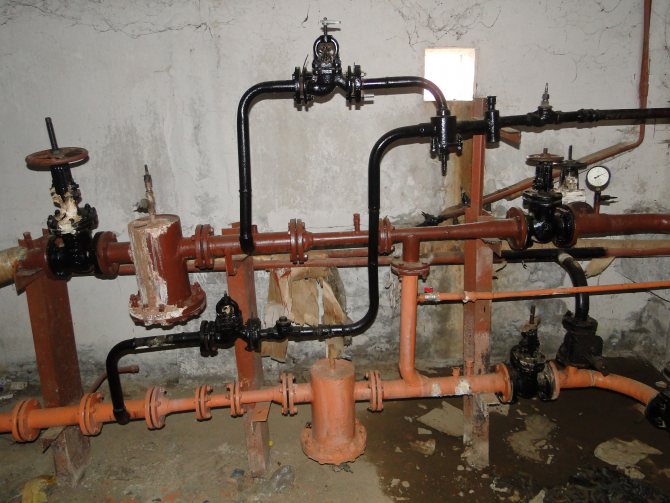

Black pipes and valves in the foreground - hot water connections
Hint: the fittings in the elevator unit also undergo an annual check by the representatives of "Teploset", so its malfunctions are extremely rare.
Replacing water risers: how not to go to court on a claim from the management company of a house?
27.06.2019
Housing and communal services / Management companies and HOAs
Situation: in all apartments of high-rise buildings, located one on top of the other, the water pressure dropped. To get really hot water from the hot tap, you have to keep the tap open for a long time. While the water is still getting hot ... And the meter is spinning during that time, and you have to pay for the measured water according to the tariff, like for hot water.
The tenants are unhappy. They write letters to the management company (well, or to the HOA, who knows how). Utilities begin checking the hot and cold water risers in all apartments below the problem areas. Sooner or later, but the "culprit" is revealed.
Most often, this is the owner of one of the apartments, who replaced the riser during the repair (or made serious changes to it). What happens next? The answer is in the history of the trial in the case of the converted water risers, which took place in one of the district courts of the city of Orenburg.
Unauthorized replacement of hot and cold water risers?
As follows from the materials of the case, for some time now the tenants began to contact the management company of the apartment building with complaints about the quality of the water supply. The Criminal Code conducted a tour of the apartments to find out the cause of the problem.
In one of the apartments, it was discovered that the owner had replaced the metal pipes of the risers with polypropylene ones. At the same time, at the junction of plastic pipes with metal pipes, the diameter of the pipes was narrowed.
In addition, new polypropylene pipes have been laid with numerous bends. In the elbows formed in this way, the diameter of the pipes was also narrowed.
Finally, a faucet was installed on the hot water riser.In the closed position, it completely blocked the direct flow of water through the hot water riser, directing it through the heated towel rail in the bathroom.
The management company demanded to dismantle all these "reconstructions" and return the risers to their original position, about which the owner, as well as the person living in the apartment, were officially notified. However, neither one nor the other took any action. In response, the management company went to court.
Court in the case of replacing water risers
In the court proceedings, the representative of the apartment owner made the following arguments:
- The risers were replaced with the knowledge of the management company. In particular, in the course of the work, its employees blocked the risers and drained water from them. After the work, the risers were "accepted" by the representative of the UK. There have been no complaints from public utilities for nine years.
- Replacing metal pipes with plastic ones in itself is not a serious reorganization and does not require a change in the registration certificate of the apartment. At the same time, the inner diameter of plastic pipes turned out to be even slightly larger than that of metal ones. The walls of plastic pipes themselves are smoother than those of metal ones. This facilitates the flow of water.
- The constrictions existing on the new risers do not affect the throughput of the pipes. While maintaining pressure, a smaller pipe diameter is compensated by a local increase in the water flow rate
- In confirmation of his calculations in terms of the fact that the flow of water does not depend on the inner diameters of the pipe in places of narrowing, the owner provided an expert opinion from one of the industry research institutes and design organization.
- And in general, according to building codes, metal hot water risers require replacement every twenty years. The house was built in 1997 and the risers had to be changed anyway
- As for the tap that closes the hot water riser, then when it is closed, the water continues to flow through the heated towel rail and the apartments from above should not feel any difference from whether it is closed or open.
What the court decided:
- Pipes in their original state (i.e. put metal back) allowed not to bring (i.e. you can leave polypropylene)
- The narrowing of the risers of hot (seven places) and cold (eight places) water, the court decided to remove. The court did not take into account the expert opinion that the pressure did not suffer because of the bottlenecks, deciding that they dealt with the problem "in general", and there are no results of practical measurements of the water flow rate in the risers above the defendant's apartment.
- The court allowed not to dismantle the tap on the hot water riser. The judge motivated his position by the fact that the Criminal Code did not provide evidence that by letting hot water through the heated towel rail, the owner of the apartment reduced, thus, its pressure when it was supplied to the apartments above.
What to think about when deciding to replace the water risers in the apartment
What's the bottom line? Of all the claims of public utilities, the court upheld only the requirement to remove the narrowing points on the risers of cold and hot water. As far as can be understood from the text of the court's decision, we are talking about metal fittings that were used in places of turns. Probably, it will not be so difficult to do this if there is access to the pipes.
Will the situation with hot water in the apartments above improve as a result? Unfortunately, this is not clear from the court's decision. Quite possibly not. The problem may be elsewhere, where precipitation has accumulated in the turn of the water pipe in the past twenty years after the construction of the house.
But, unfortunately for the owner of the apartment in question, there is a kind of "presumption of guilt" in his relation. Changes to the common water supply system? Did you not secure them with an act signed by a representative of the management company? So, be ready for the demands to return everything to its previous state.And then it depends on the owner of the apartment whether he will immediately agree to the demands of the utilities or fight them, including in court.
And what to do, you ask? An unambiguously reliable solution to the problem is to do all the work on the riser, involving the management organization. This, by the way, is their duty, and utilities in this case have no right to demand payment from the owner.
Of course, all kinds of little "tricks" in the form, for example, of a tap on a hot water riser, directing the flow of water through a heated towel rail, thus, you will not be able to carry out. But you will not receive any claims for unauthorized reorganization of the riser from public utilities.
The full text of the decision in the case of unauthorized reconstruction of cold and hot water risers in an apartment is available on the website of the Dzerzhinsky District Court of the city of Orenburg.
Heating
Turning off the heating riser is necessary in three cases:
- If a heating riser leaks in your apartment;
- If the radiator is leaking (through the plug, through the connection, along the Mayevsky tap, between the sections) and the connections are not equipped with shut-off valves;
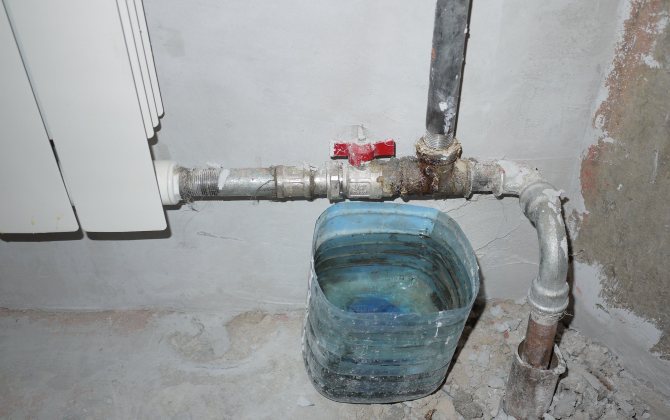

Leakage of the line to the shut-off valve
Attention: if taps are installed on the connections, the heater must be equipped with a jumper between the connections installed before the taps. Otherwise, you will not turn off your battery with them, but stop circulation in the entire riser. Very soon, freezing neighbors will come to you and begin to utter evil and offensive words.
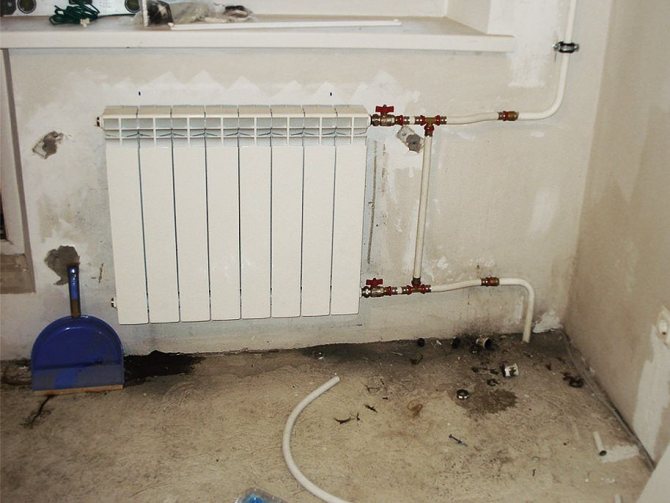

Pay attention to the bypass in front of the ball valves on the connections
- If you are drowned from above with warm water in rooms in which there is no water supply (simply put, in living rooms).
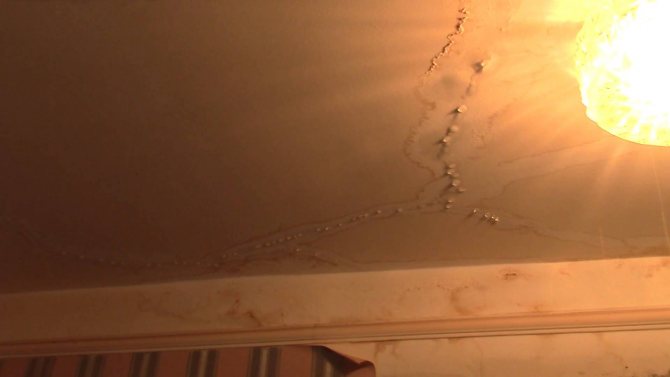

Living room flooding
Finding and disconnecting a riser
The way the heating is turned off depends on the type of heating system. Here, again, you will have to delve a little into the theory.
Most modern buildings are designed with bottom heating. This means that the supply and return spouts are distributed in the basement (usually along the perimeter of the outer walls of the house).
At bottom filling, the heating risers are connected to the return and supply alternately. Each pair of risers is connected by a jumper located on the top floor. To drain your riser, you need to block one of the adjacent ones with it.
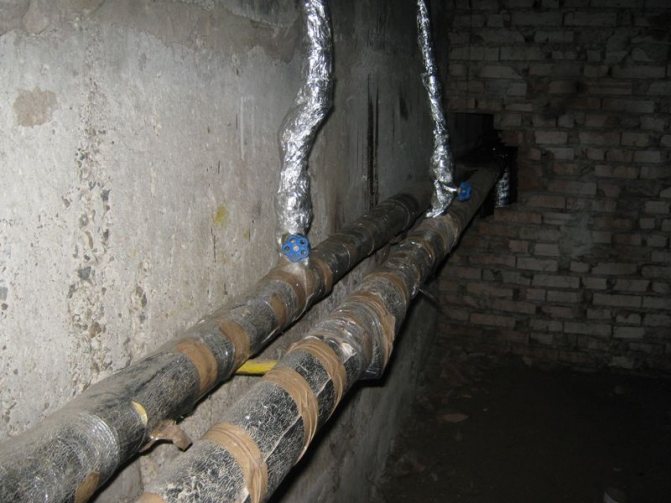

Paired risers in a bottom filling system
Hint: the search for the riser connected to yours is carried out in the same way as for the DHW.
In the case of top filling, the heating supply is carried out to the attic. Each riser is disconnected independently of the others, but at two points - in the basement and in the attic.
To find a riser in the attic, be guided by the number of windows (and, accordingly, heating devices) from the nearest corner of the house or by the entrances (in the event that there are light windows in the attic).
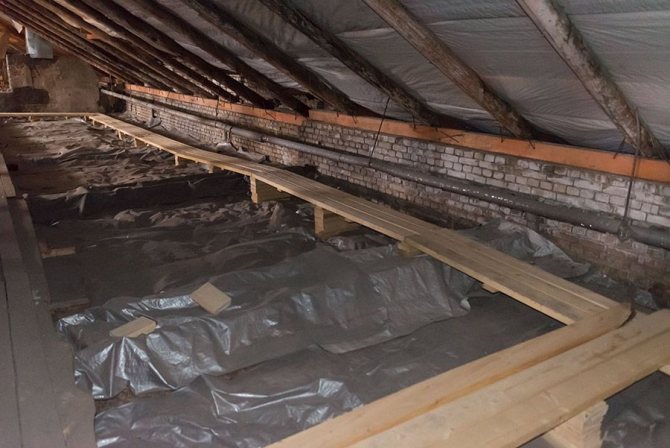

Top filling: supplying heating in the attic
Attention: the cap in the attic needs to be unscrewed only if you need to completely drain the riser and heating devices (water will inevitably hang in the pipe closed from above). To eliminate leaks that are not associated with a complete disassembly of the supply line, it is enough to close both valves and unscrew the plug in the basement.
What if the valves on your riser are faulty?
Turning off heating by the elevator
It all depends on the type of heating filling in your house. There are two options:
- A house with a top spout can be reset in an emergency. In this case, it is imperative to open the air vent on the expansion tank mounted at the top of the supply filling in the attic. In this case, there will be no water left in the risers and heating devices, and they will not be exposed to the danger of defrosting;


In a top-dispensing system, water does not freeze when discharged
- In the case of bottom filling, the house heating must not be turned off categorically. At negative temperatures, this will lead to defrosting of the access heating - it will rupture with water hanging in risers and radiators.And even at positive temperatures, some of the risers will be aerated, which means a significant amount of work for residential residents to restart heating.
Hint: The invoice for this work will be charged to the culprit of the unauthorized shutdown.
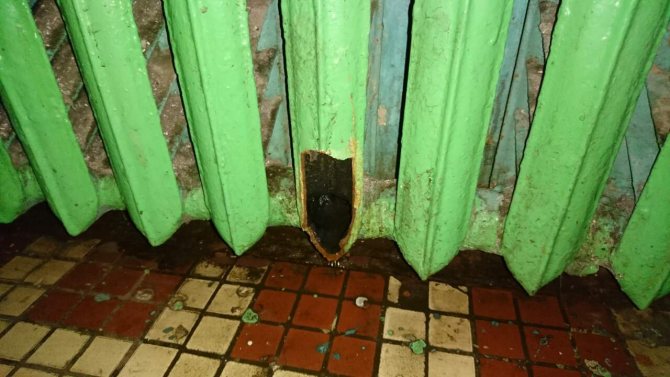

Defrosted access heating radiator
How do I reset the heating in a top-drawer house?
Very simple:
- Close the house (heating) valves. Recall that they are easy to find in the direction of the elevator bell;
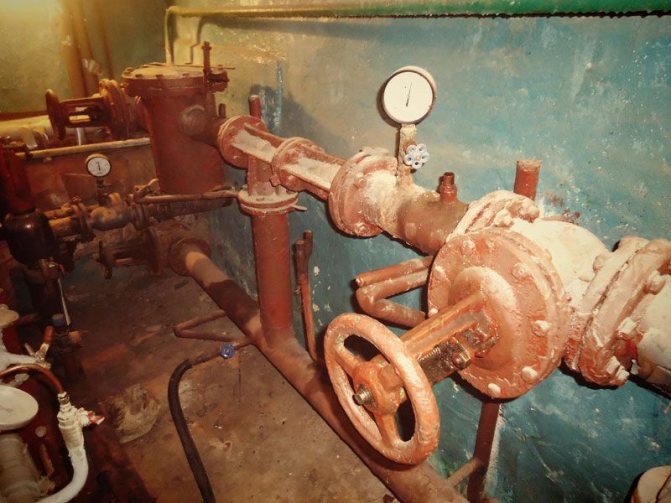

Closed house valve
- Open the relief valves located immediately after them. Usually, the discharges are discharged into the sewer, less often - they open to the floor of the elevator unit or the adjacent section of the basement;
- Go up to the attic and open the vent on the expansion tank. He must suck in air so that the water does not get stuck in the risers.
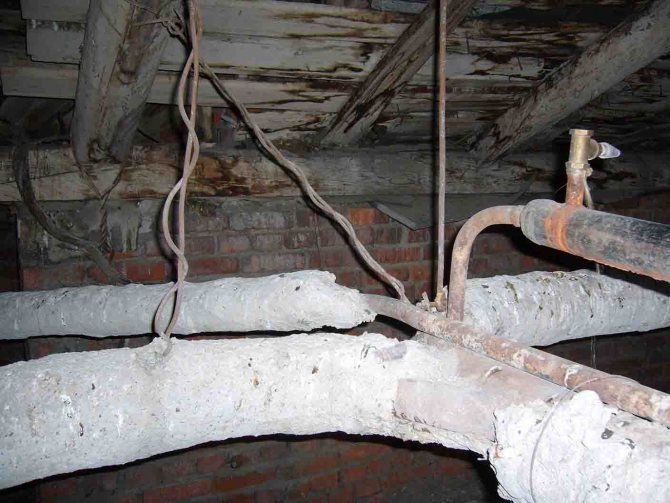

Vent on the top filling (right)
Hint: When starting a house with an overhead filling, the air vent must be closed. Air is vented after filling the heating circuit from both lines.
Plug Installation Procedure
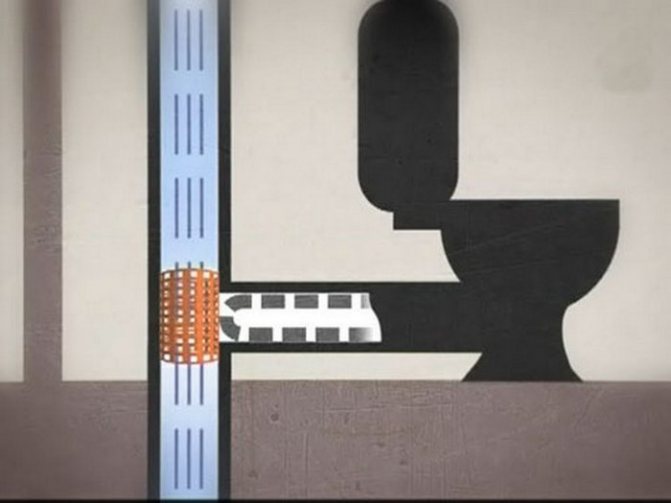

Housing and communal services and private companies install plugs in such a way that drains from all other apartments pass through the riser without hindrance through the sewer pipe. However, drains from the debtor's apartment cannot enter the common house riser.
To perform such a complex plug installation, special equipment is required:
- remote control video cameras;
- manipulators;
- fiber optic wires for lighting.
If the necessary equipment is available, housing and communal services workers or another office that disconnects debtors do the following:
- First of all, employees must study the features of the sewer system, that is, understand what material the pipes are made of, and whether there is a second riser to which sewage drains from the debtor's apartment can be connected.
- Then the specialist must determine the place where the plug will be installed. Usually, for the installation of the plug, an intra-apartment pipe is used, which goes from the toilet bowl to the common sewer riser.
- Now you need to find the entry point, that is, the place from where the equipment can be lowered into the sewer system. This is usually done through a drain pipe on the roof of the house, coming from the sewer riser, or through an apartment located above the debtor's premises (for this, you must first agree with the tenants of the apartment above and obtain their permission).
- A manipulator is lowered into the inspection hatch or pipeline, which has a remote control. A fiber-optic light guide and a video camera are attached to the manipulator.
- Further, the plug is lowered along the common house riser to the place where the sewer exits the debtor's apartment. It is inserted into the side outlet of the apartment's sewage system.
- After that, the plug is fixed. The choice of fixing method depends on the materials from which the plug and the sewer pipeline are made.
Now, after installing the plug, the wastewater will be completely or partially retained in the apartment's sewage system. At the same time, the riser itself will continue to work to divert wastewater from all other apartments.
Safety
What should not be done when working with heating and water supply and how to ensure maximum safety of all work:
- Never try to seal a leak under pressure (except by bandaging small fistulas). An attempt to rewind a locknut on a battery or a liner can turn into a rotten liner torn off along the thread, an attempt to tighten Mayevsky's dripping tap - by breaking the thread on it;
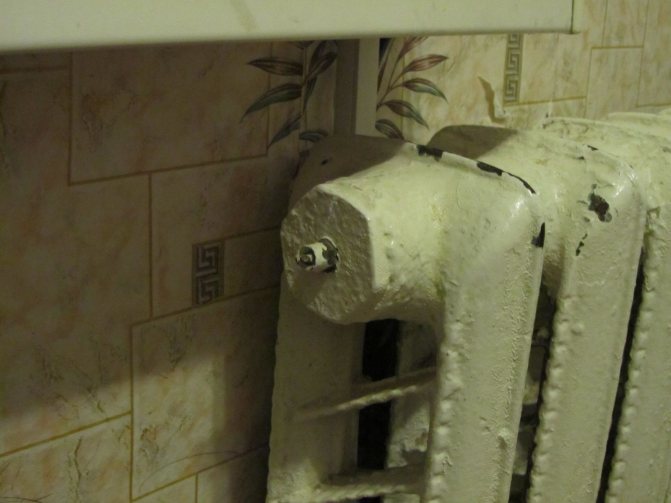

Mayevsky's crane in a radiator plug
- If you turn off the water for minor repairs in your own apartment, be sure to notify the neighbors in the riser about this. Otherwise, the emergency service that arrived at their request may turn on the water at the moment when your eyeliner is disassembled;
- After turning off the water or heating, hang a sign on the valve or valve indicating the reason for the shutdown, apartment number and your telephone. This simple measure, again, will save you from flooding when working in an apartment or a conflict with representatives of the emergency service;
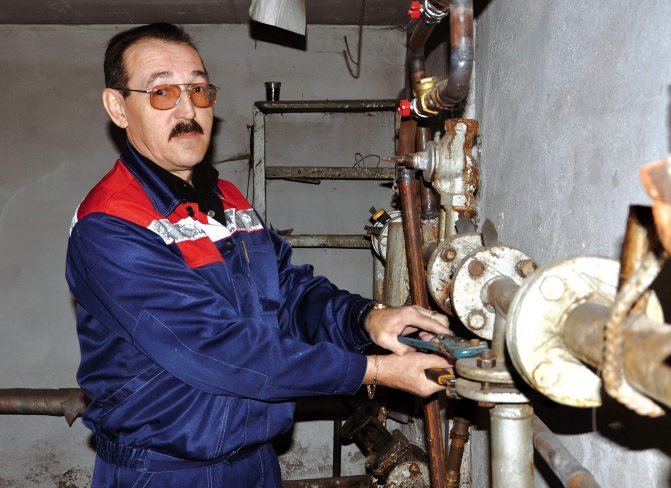

Emergency gang who arrived on call can turn on the water at the most inopportune moment
- Never turn off the heating during the heating season in the absence of an emergency. All work on the replacement of radiators, their transfer, etc. are held in the summer. Lack of heating for several hours is a reason for recalculation of payments for this service by end users - your neighbors.
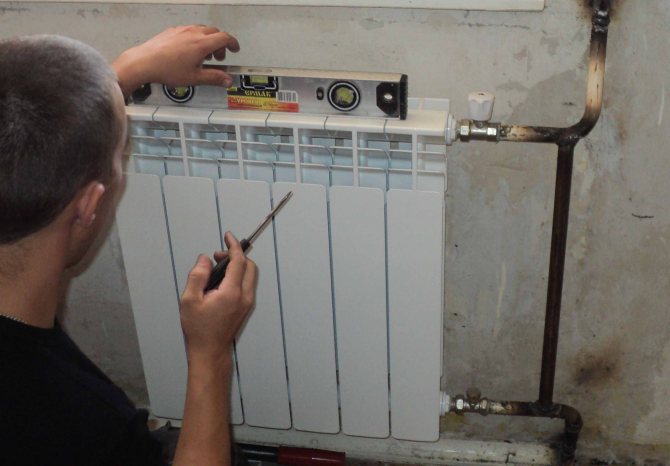

All heating modernization works are carried out outside the heating season
Who to entrust the performance of work
Since you still have to pay, it is better to do everything at once. Anyway, with all the radiators on the same riser. And here the question arises: who will carry out this work. To get started, you can go to the housing office or DEU, ask about their prices. As a rule, the prices there are rather big, and the quality of work is not up to par. To be convinced of this, you can ask the neighbors who have already dealt with them.
You can find a private trader. Only not from ads, but on the recommendations of acquaintances, colleagues, friends. Their rates are rarely higher than those of the operators. Better quality is their bread: if they do a poor job, there will be no customers. Therefore, they try (if they are sane) to do everything conscientiously.
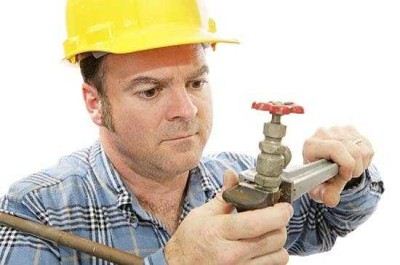

Choosing a performer is not an easy task
There is also an opportunity to negotiate with an employee of the housing office bypassing the cash register. But here the option is controversial. Firstly, they tend to ask for a price based on the client's wealth and it is far from the fact that they will demand less than the price. Rather, more. And why, tell me, for the same quality of work (they are unlikely to work harder than at the main job) pay more?
Another option is to contact a specialized organization. And again, it is desirable for recommendations. Although, organizations are forced to monitor the quality of work for mundane reasons: they need clients. If they have a bad reputation, no one will go to them.
Therefore, if you do not know the organization, there are no recommendations, you can pay attention to the period of its existence on the market. If this is not a year, or two, then it is unambiguous that they know how to do something, otherwise they would not have existed so much
Naturally, pay attention to the services they provide. Many offer questions with the permission and disconnection of risers, agreeing with the management or operating organization to take over. You only stipulate the list of works and time. How much will it cost? In different ways: organizations, like their leaders, are different. It may be more expensive than the work of a locksmith from the housing office, but at least you will have a claim to someone in case of problems: you sign an agreement in which it will be clearly described who is doing what.
And the most economical option is to do everything yourself, with your own hands. It's not an easy matter, but the gods do not burn the pots. Only first you need to find out everything to the smallest detail, purchase everything you need, prepare the tools and equipment and only after that write an application to disconnect the riser.
This all concerned planned repair or maintenance work. If a radiator or pipe is leaking, you definitely have to act yourself. Read here how to fix a radiator leak.

